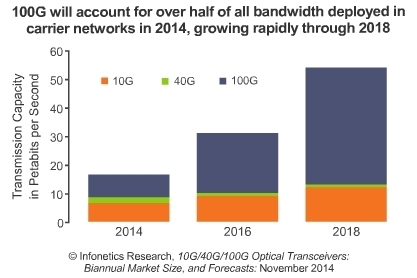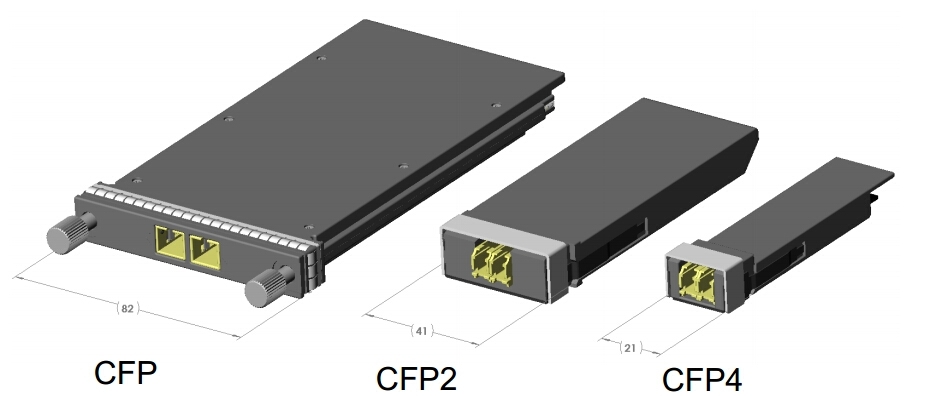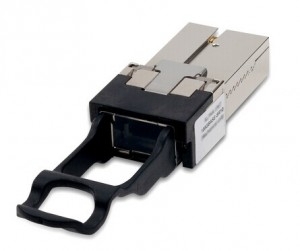- Related articles
- How to Reduce PCIe Bus Latency?
- Optical Transceivers for Cisco WS-C2960XR-48LPD-I Switch
- Optical Transceivers for Cisco SRW224G4-K9-UK Switch
- Optical Transceivers for Cisco WS-C3560V2-48PS-S Switch
- All Cisco ONS-XC-10G-L2's information (List price, Specs, Datasheet PDF, Compatibility mat
- All Cisco MA-SFP-1GB-SX's information (List price, Specs, Datasheet PDF, Compatibility mat
- Optical Transceivers for Cisco WS-C3750G-48TS-S Switch
- The Things You Need to Know about 10GBASE-EW Ethernet Standards
- Apply to 100BASE-BX-U Standard Optical Transceiver Models
- Introducing Cisco S-Class 10GBASE SFP+ Modules

100G Ethernet Develops Rapidly
With the increasing demands of higher speed and greater bandwidth, more and more people are looking forward to the coming of 100G Ethernet. In fact, with the rapid development in these few years, 100G Ethernet is getting closer to us. According to the latest report from Infonetics, 100G accounts for over half of all bandwidth deployed in carrier networks in 2014, and will grow rapidly through 2018. As you can see from the diagram below, in 2014, the 100G is on par with the 10G, but in 2016, it exceeds the 10G and grow rapidly in 2018.

The explosive growth in mobile data traffic, data centers, and cloud services are the catalysts behind significant traction of 100G deployments in the Core and Long Haul networks. Service providers and carriers are accelerating the deployment of 100G but also looking carefully to manage their CAPEX and OPEX effectively. Many company, such as Cisco, Alcatel-Lucent, Brocade, and Juniper Networks have introduced 100G equipment. By 2015, higher-speed Ethernet will have about a 25% share of network equipment ports, according to Infonetics Research.
Development of 100G Ethernet Optical Transceiver
To build and support the 100G Ethernet, usually needs a variety of technologies and devices. The 100G transceiver is one of the essential one, because fiber connectivity in higher-speed active equipment is being condensed and simplified with plug-and-play, hot-swap transceiver miniaturization. As we know, 1G and 10G networks commonly utilize the GBIC (Gigabit interface converter) or SFP (small form-factor pluggable ), while for 8G Fibre Channel SAN (Storage Area Network) and OTU2, as well as some 10G, the transceiver is the SFP+ (small form-factor pluggable plus). The transceiver develops today, there are QSFP (quad small form-factor pluggable), CFP and CXP (100G form-factor pluggable) respectively for 40G and 100G active equipment. In addition, MPO/MTP is the designated interface for multimode 40/100G, and it’s backward compatible with legacy 1G/10G applications as well. Its small, high-density form factor is ideal with higher-speed Ethernet equipment. We may be familiar with the transceivers for 1G, 8G, 10G and 40G as we often mention. Thus, we will mainly introduce the 100G transceivers in the next content.
Multipurpose CFP Transceiver
The CFP Multi-Source Agreement (MSA) defines hot-pluggable optical transceiver form factors to enable 40Gbps and 100Gbps applications, including next-generation High Speed Ethernet (40GbE and 100GbE). CFP supports both single-mode and multi-mode fiber and a variety of data rates, protocols, and link lengths, including all the physical media-dependent (PMD) interfaces encompassed in the IEEE 802.3ba standard. At 40GbE, target optical interfaces include the 40GBase-SR4 for 100 meters (m) and the 40GBase-LR4 for 10 kilometers (km). There are three PMDs for 100 GbE: 100GBASE-SR10 for 100 m, 100GBASE-LR4 for 10 km, and 100GBASE-ER4 for 40 km.

CFP was designed after the Small Form-factor Pluggable transceiver (SFP) interface, but is significantly larger to support 100Gbps. The electrical connection of a CFP uses 10 x 10Gbps lanes in each direction (RX, TX). The optical connection can support both 10 x 10Gbps and 4 x 25Gbps variants. CFP transceivers can support a single 100Gbps signal like 100GE or OTU4 or one or more 40Gbps signals like 40GE, OTU3, or STM-256/OC-768.
In addition, the CFP-MSA Committee has defined three form factors:
CFP – Currently at standard revision 1.4 and is widely available in the market
CFP2 – Currently at draft revision 0.3 is half the size of the CFP transceiver; these are recently available in the market
CFP4 – CFP4 is half the size of a CFP2 transceiver, and is still rare in the market.

Pluggable CFP, CFP2 and CFP4 transceivers will support the ultra-high bandwidth requirements of data communications and telecommunication networks that form the backbone of the internet.
High-density CXP Transceiver
CXP is targeted at the clustering and high-speed computing markets and is the complement to CFP for Ethernet. Technically, the CFP will work with multimode fiber for short-reach applications, but it is not really optimized in size for the multimode fiber market, most notably because the multimode fiber market requires high faceplate density.

The CXP is 45 mm in length and 27 mm in width, making it slightly larger than an XFP or 1/4 size of a CFP transceiver. It provides higher density network interfaces. It is a copper connector system specified by the InfiniBand Trade Association. It provides twelve 10 Gbps links suitable for 100 Gigabit Ethernet, three 40 Gigabit Ethernet Channels, or twelve 10 Gigabit Ethernet Channels or a single Infiniband 12× QDR link.
The CFP and CXP optical transceiver form factors are hot pluggable, both feature transmit and receive functions, and both support data rates of 40 and 100 Gbps. But the similarities begin and end there. Aimed primarily at 40- and 100-Gigabit Ethernet (GbE) applications, the CFP supports both singlemode and multimode fiber and can accommodate a host of data rates, protocols, and link lengths. The CXP, by contrast, is targeted at the clustering and high-speed computing markets. The CFP and CXP form factors are complementary, with the CFP likely gaining traction in applications like Ethernet switches, core routers, and optical transport equipment, and the CXP covering the data center market.
Cozlink 100G Transceiver Solution
Cozlink 100G transceiver solution offers customers 100 Gigabit Ethernet connectivity options for data center networking, enterprise core aggregation, and service provider transport applications. We highly recommended 100GBASE-LR4 CFP2 and CFP4 modules. With the high compatibility, the CFP2 and CFP4 optics can be compatible with all kinds of equipment. In addition, our 100G transceivers offer significant advantages over existing solutions in terms of reduced power dissipation and increased density with the added benefit of pluggability for reduced first installed cost.
Recommendation of Excellent Products
| Model # | Description | Applications |
| CFP2-100G31-10-xx | 100GBASE-LR4 CFP2 1310nm 10km Optical Transceiver Module for SMF (DDM / ODM) | OTU4 4I1-9D1F Client Applications / 100GBASE-LR4 100G Ethernet / CFP MSA module form factor |
| CFP2-100GT31-10-xx | 100GBASE-LR4 and OTN Multirate CFP2 1310nm 10km Optical Transceiver for SMF (DDM / ODM) | OTN OTU4 4I1-9D1F / 100GBASE-LR4 100G Ethernet / Proprietary protocol and density application / Ethernet switches and router applications |
| CFP4-100G31-10-xx | 100GBASE-LR4 CFP4 1310nm 10km Optical Transceiver for SMF (DDM / ODM) | 100GBASE-LR4 100G Ethernet / Proprietary protocol and density application / Ethernet switches and router applications |
| CFP4-100GT31-10-xx | 100GBASE-LR4 and OTN Multirate CFP4 1310nm 10km Optical Transceiver for SMF (DDM / ODM) | OTN OTU4 4I1-9D1F / 100GBASE-LR4 100G Ethernet / Proprietary protocol and density application / Ethernet switches and router applications |
100G Direct Cabling Solutions:
100G Breakout Cabling Solutions:
Future Trend of Optical Transceivers in Data Centers
What is the standard for 100G transceiver?
Standards of 100G Transceivers Since the advent of the 100G network, IEEE, multi-source Protocol (MSA) and so on proposed a variety of standards for the 100G optical transceiver. In these standards, the PSM4 and CWDM4 standards developed by MSA industry organizations are more suitable for 100G QSFP28 optical transceivers in the market. The following table shows the details of the 100G optical transceiver standard.

Notes: 1,Fiberroad may make changes at any time to the products or specifications contained herein without notice, pls contact with our sales for more details.
Different Types of 100G Optical Transceiver Connectors
The most common types of connectors in 100G optical modules are SC / LC / MPO and others. In the traditional 10G interface, SC/LC connectors are usually used to form dual-core interconnect single-income hairs. LC and SC connectors use a very similar structure and principle, but the LC connectors have a smaller size.
The MPO connector is a multiple fiber push-on / push-off all-in-one form adapter. This connector uses parallel technology, multiple transponders are designed into the same box, and they are combined together by multiple optical fibers. composition. There are two common MPO models on the market: MPO12 and MPO24.
MPO12 has 12 optic cores, four of these are receivers, another four are transmitters, and the remaining four are vacant fibers. These 12 fibers contain 4 idle, so this standard is SR4/LR4.
MPO 24 is defined as a 24-core, 12-wire, 12-wire, 24-wire welded 12-core fiber array. One of the fibers is used for the transmitter and the other fiber is used for the receiver. When it is used for CFP 100G optical module, in an array, the middle 10*10G fiber is used to transmit traffic, and the outermost two fibers are idle. There are a total of 4 fibers idle in both arrays, so it's formatted as SR10. When it's used for a CXP module, there are 12 transmit fibers and 12 receive fibers, and no idle lines.
In the case of the QSFP28 100G optical module, for example, if the transceiver uses a splitter and multiplexer internally to modulate 4 channels of 28G data to the optical fiber, and the external transceiver is a single payload single LC interface, which saves a lot of fiber resources when applied to long-distance transmission. This multi-fiber fiber optic transmission technology is WDM, which is widely used in the construction of 5G base stations. MPO connectors are usually used for short-distance transmission, while for long-distance transmission, LC connectors are used to save fiber.
Can Different 100G Optical Transceivers Interconnect?
100G optical transceivers of the same type can interconnect with other modules. For instance, a CXP can be interconnected with a CXP, a CFP-SR10 can be interconnected with a CFP-SR10. When communication needs to be established between different types of 100G transceivers they need to be of the same standard and interface type. Another example, the CFP / CFP2 / CFP4 can transmit with the QSFP28 under the same signaling system and interface type. CFP2-LR4 with a duplex LC interface can communicate with QSFP28-LR4 under a duplex LC interface. The 100G CXP transceiver can only interconnect with the CFP/CFP2/CFP4/QSFP28 optical transceiver when the SR10 standard is used. When interconnecting the CXP module and CFP2-SR10 module, CXP must mask off 1, 12, 13, and 24 at the edge of CXP, since CXP is a 12-channel transceiver and CFP2 is a 10-channel transceiver.
Types of 100G Optical Transceiver Connectors
Common connector types are: SC / LC / MPO and so on. The traditional 10G interface often use SC / LC connectors in the form of dual-core interconnect single-income hair. LC connector and SC connector are similar, but the LC connector is smaller than the SC.
MPO connector is a multiple fiber push-on / push-off all-in-one adapter. In simple terms, it is the use of parallel technology, the number of transponders in a box and the final combination of multiple optical fibers. MPO is divided into MPO12 and MPO24;
MPO 12 is 12 cores with 4 receivers and 4 transmissions, using 12 optical fibers, there are 4 idle, so the standard is SR4 / LR4.
The MPO 24 is a 24-core, 12-wire, 12-wire, 24-wire optical fiber soldered into 12-core arrays, one for transmit and one for receive. Take CFP as an example, in each array, the middle 10 * 10G optical fiber is used to transmit traffic, while the two optical fibers at both ends are idle. A total of four of the two arrays are idle, so the format is SR10. CXP module is 12 transmit and 12 receive, there is no idle line.
Take QSFP28 as an example, if the module inside uses splitters and multiplexers to 4 way 28g data modulated onto a fiber, the external transceiver is a single pay-single LC interface, so for long-distance can save fiber. This kind of optical fiber transmission technology with multiple optical fibers is called wavelength division multiplexing (WDM). Generally, short-distance uses MPO type, long-distance uses LC interface type for saving fiber.





















































